Glocalisation Framework and International Entry Modes for Global Marketing | Desklib
VerifiedAdded on 2023/06/08
|9
|2712
|383
AI Summary
This article discusses the glocalisation framework, think globally and act locally strategy, India's market potential, internationalization triggers and motives, waterfall and shower approach for international entry modes in global marketing. It also provides real business examples and benefits of these strategies. The subject is global marketing and the course code is not mentioned. The content is relevant for students pursuing business and marketing courses in any college or university.
Contribute Materials
Your contribution can guide someone’s learning journey. Share your
documents today.
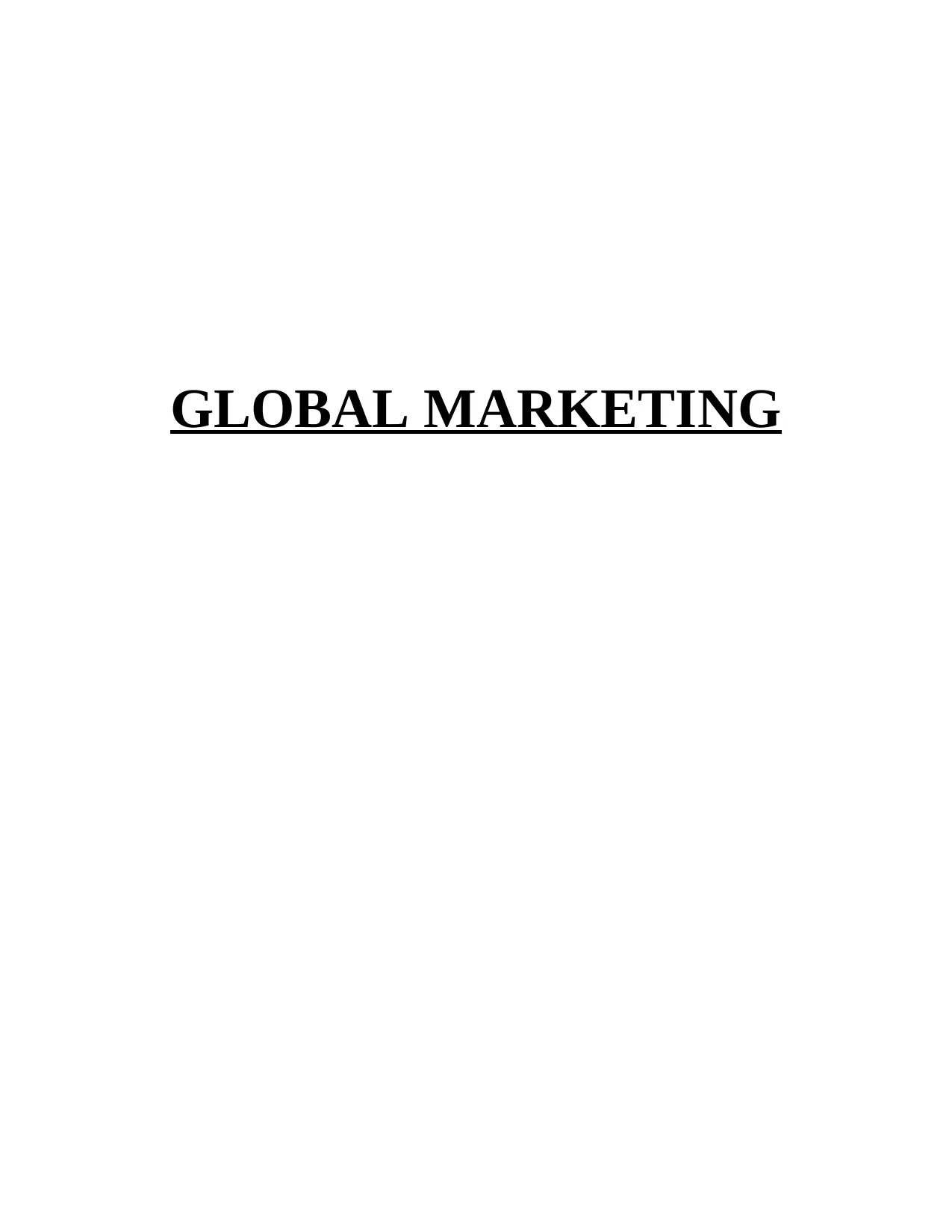
GLOBAL MARKETING
Secure Best Marks with AI Grader
Need help grading? Try our AI Grader for instant feedback on your assignments.
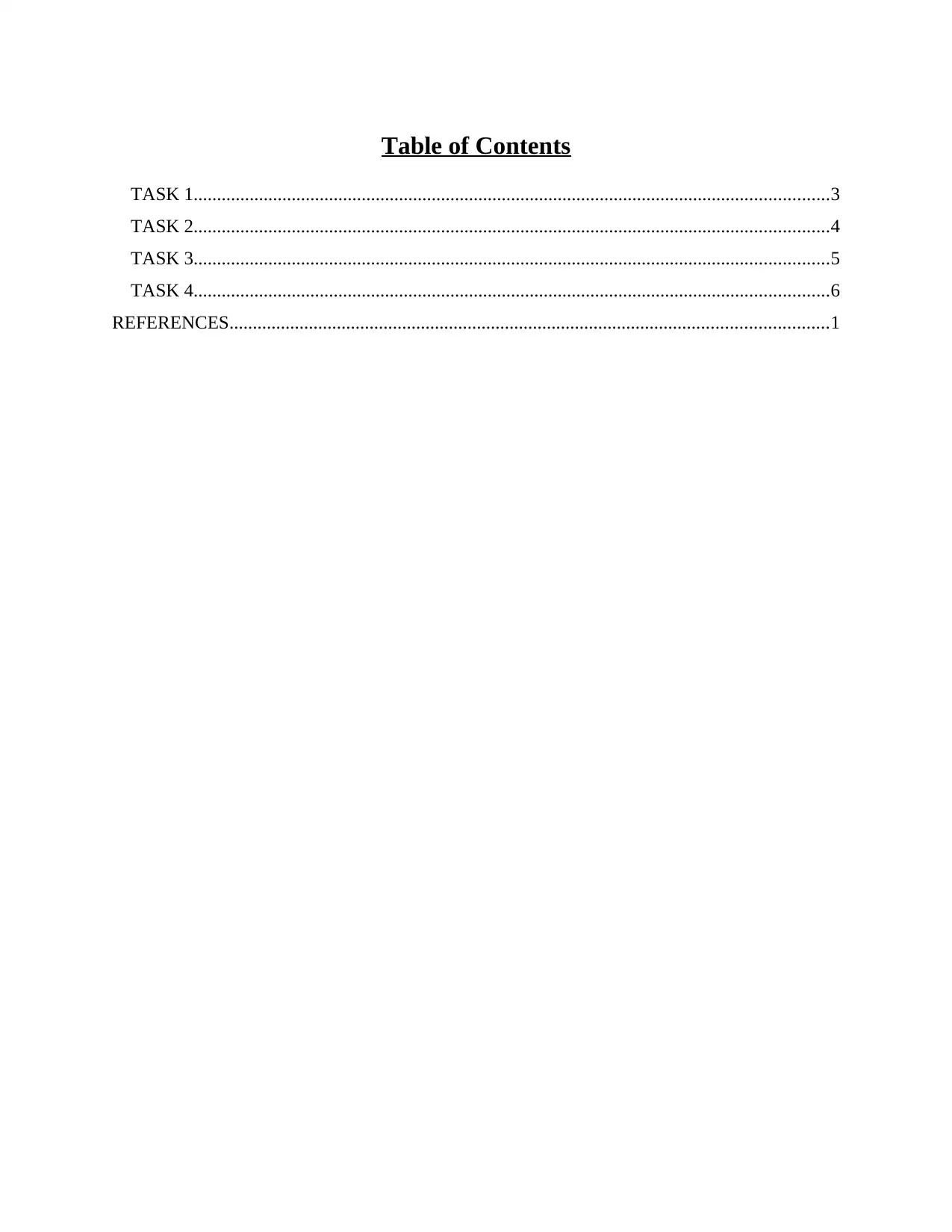
Table of Contents
TASK 1........................................................................................................................................3
TASK 2........................................................................................................................................4
TASK 3........................................................................................................................................5
TASK 4........................................................................................................................................6
REFERENCES................................................................................................................................1
TASK 1........................................................................................................................................3
TASK 2........................................................................................................................................4
TASK 3........................................................................................................................................5
TASK 4........................................................................................................................................6
REFERENCES................................................................................................................................1
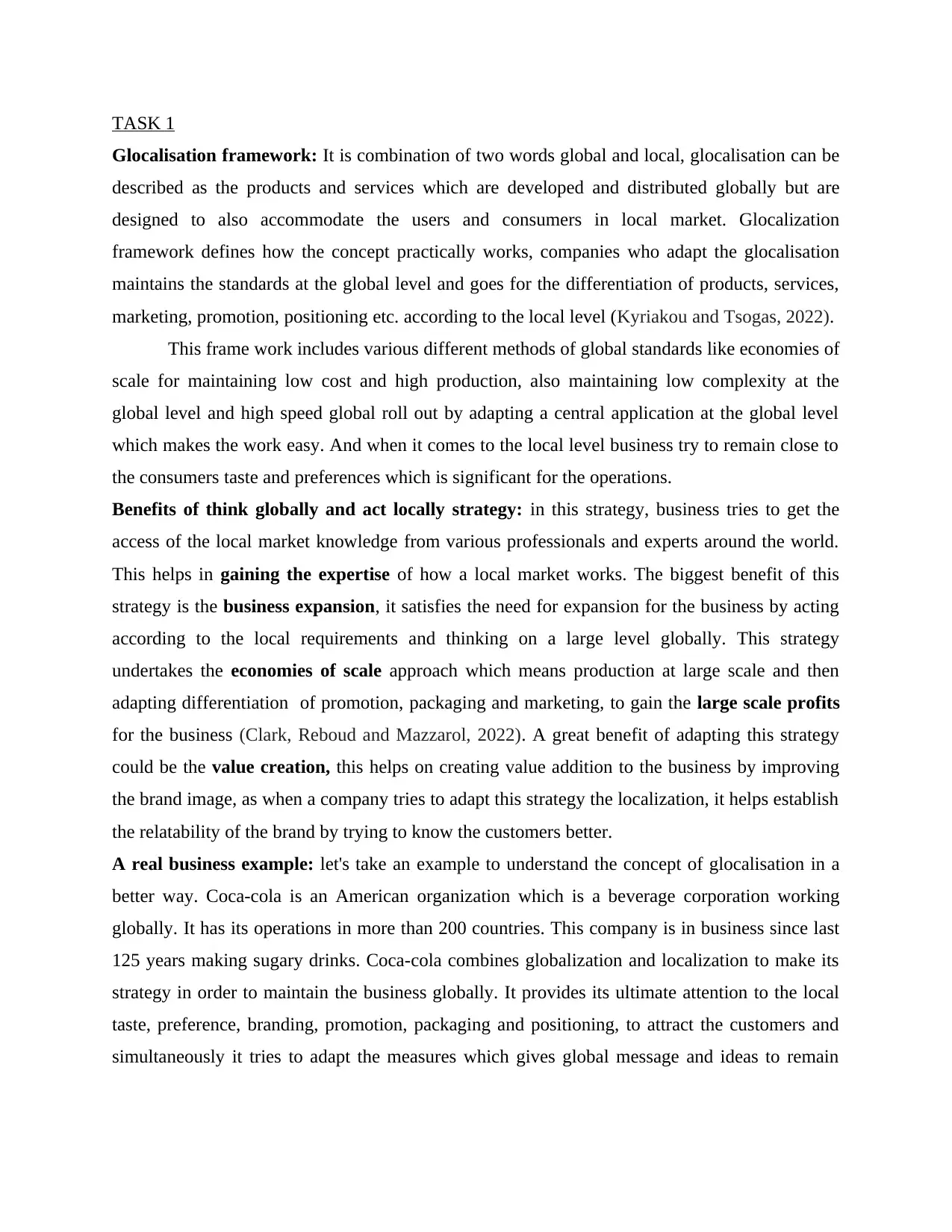
TASK 1
Glocalisation framework: It is combination of two words global and local, glocalisation can be
described as the products and services which are developed and distributed globally but are
designed to also accommodate the users and consumers in local market. Glocalization
framework defines how the concept practically works, companies who adapt the glocalisation
maintains the standards at the global level and goes for the differentiation of products, services,
marketing, promotion, positioning etc. according to the local level (Kyriakou and Tsogas, 2022).
This frame work includes various different methods of global standards like economies of
scale for maintaining low cost and high production, also maintaining low complexity at the
global level and high speed global roll out by adapting a central application at the global level
which makes the work easy. And when it comes to the local level business try to remain close to
the consumers taste and preferences which is significant for the operations.
Benefits of think globally and act locally strategy: in this strategy, business tries to get the
access of the local market knowledge from various professionals and experts around the world.
This helps in gaining the expertise of how a local market works. The biggest benefit of this
strategy is the business expansion, it satisfies the need for expansion for the business by acting
according to the local requirements and thinking on a large level globally. This strategy
undertakes the economies of scale approach which means production at large scale and then
adapting differentiation of promotion, packaging and marketing, to gain the large scale profits
for the business (Clark, Reboud and Mazzarol, 2022). A great benefit of adapting this strategy
could be the value creation, this helps on creating value addition to the business by improving
the brand image, as when a company tries to adapt this strategy the localization, it helps establish
the relatability of the brand by trying to know the customers better.
A real business example: let's take an example to understand the concept of glocalisation in a
better way. Coca-cola is an American organization which is a beverage corporation working
globally. It has its operations in more than 200 countries. This company is in business since last
125 years making sugary drinks. Coca-cola combines globalization and localization to make its
strategy in order to maintain the business globally. It provides its ultimate attention to the local
taste, preference, branding, promotion, packaging and positioning, to attract the customers and
simultaneously it tries to adapt the measures which gives global message and ideas to remain
Glocalisation framework: It is combination of two words global and local, glocalisation can be
described as the products and services which are developed and distributed globally but are
designed to also accommodate the users and consumers in local market. Glocalization
framework defines how the concept practically works, companies who adapt the glocalisation
maintains the standards at the global level and goes for the differentiation of products, services,
marketing, promotion, positioning etc. according to the local level (Kyriakou and Tsogas, 2022).
This frame work includes various different methods of global standards like economies of
scale for maintaining low cost and high production, also maintaining low complexity at the
global level and high speed global roll out by adapting a central application at the global level
which makes the work easy. And when it comes to the local level business try to remain close to
the consumers taste and preferences which is significant for the operations.
Benefits of think globally and act locally strategy: in this strategy, business tries to get the
access of the local market knowledge from various professionals and experts around the world.
This helps in gaining the expertise of how a local market works. The biggest benefit of this
strategy is the business expansion, it satisfies the need for expansion for the business by acting
according to the local requirements and thinking on a large level globally. This strategy
undertakes the economies of scale approach which means production at large scale and then
adapting differentiation of promotion, packaging and marketing, to gain the large scale profits
for the business (Clark, Reboud and Mazzarol, 2022). A great benefit of adapting this strategy
could be the value creation, this helps on creating value addition to the business by improving
the brand image, as when a company tries to adapt this strategy the localization, it helps establish
the relatability of the brand by trying to know the customers better.
A real business example: let's take an example to understand the concept of glocalisation in a
better way. Coca-cola is an American organization which is a beverage corporation working
globally. It has its operations in more than 200 countries. This company is in business since last
125 years making sugary drinks. Coca-cola combines globalization and localization to make its
strategy in order to maintain the business globally. It provides its ultimate attention to the local
taste, preference, branding, promotion, packaging and positioning, to attract the customers and
simultaneously it tries to adapt the measures which gives global message and ideas to remain
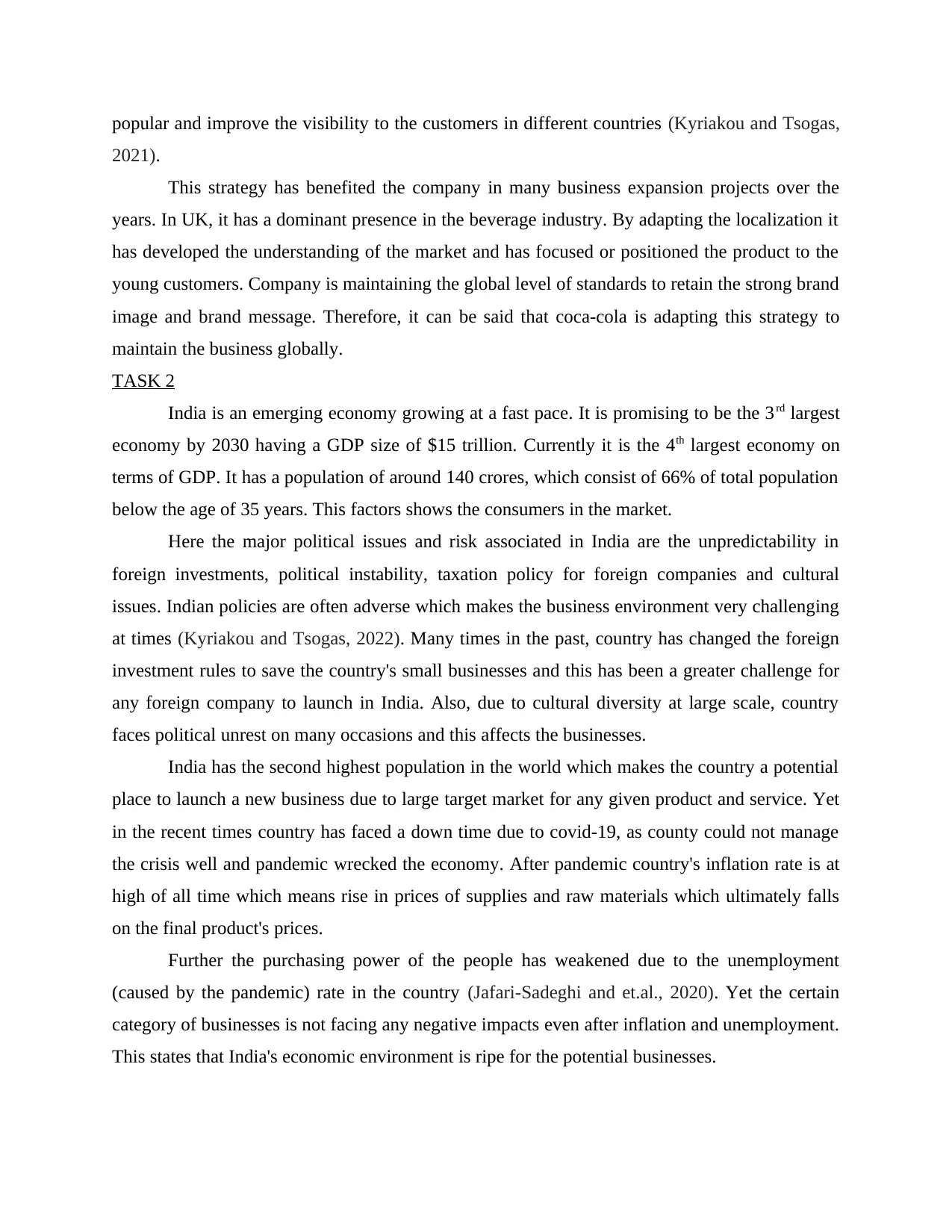
popular and improve the visibility to the customers in different countries (Kyriakou and Tsogas,
2021).
This strategy has benefited the company in many business expansion projects over the
years. In UK, it has a dominant presence in the beverage industry. By adapting the localization it
has developed the understanding of the market and has focused or positioned the product to the
young customers. Company is maintaining the global level of standards to retain the strong brand
image and brand message. Therefore, it can be said that coca-cola is adapting this strategy to
maintain the business globally.
TASK 2
India is an emerging economy growing at a fast pace. It is promising to be the 3rd largest
economy by 2030 having a GDP size of $15 trillion. Currently it is the 4th largest economy on
terms of GDP. It has a population of around 140 crores, which consist of 66% of total population
below the age of 35 years. This factors shows the consumers in the market.
Here the major political issues and risk associated in India are the unpredictability in
foreign investments, political instability, taxation policy for foreign companies and cultural
issues. Indian policies are often adverse which makes the business environment very challenging
at times (Kyriakou and Tsogas, 2022). Many times in the past, country has changed the foreign
investment rules to save the country's small businesses and this has been a greater challenge for
any foreign company to launch in India. Also, due to cultural diversity at large scale, country
faces political unrest on many occasions and this affects the businesses.
India has the second highest population in the world which makes the country a potential
place to launch a new business due to large target market for any given product and service. Yet
in the recent times country has faced a down time due to covid-19, as county could not manage
the crisis well and pandemic wrecked the economy. After pandemic country's inflation rate is at
high of all time which means rise in prices of supplies and raw materials which ultimately falls
on the final product's prices.
Further the purchasing power of the people has weakened due to the unemployment
(caused by the pandemic) rate in the country (Jafari-Sadeghi and et.al., 2020). Yet the certain
category of businesses is not facing any negative impacts even after inflation and unemployment.
This states that India's economic environment is ripe for the potential businesses.
2021).
This strategy has benefited the company in many business expansion projects over the
years. In UK, it has a dominant presence in the beverage industry. By adapting the localization it
has developed the understanding of the market and has focused or positioned the product to the
young customers. Company is maintaining the global level of standards to retain the strong brand
image and brand message. Therefore, it can be said that coca-cola is adapting this strategy to
maintain the business globally.
TASK 2
India is an emerging economy growing at a fast pace. It is promising to be the 3rd largest
economy by 2030 having a GDP size of $15 trillion. Currently it is the 4th largest economy on
terms of GDP. It has a population of around 140 crores, which consist of 66% of total population
below the age of 35 years. This factors shows the consumers in the market.
Here the major political issues and risk associated in India are the unpredictability in
foreign investments, political instability, taxation policy for foreign companies and cultural
issues. Indian policies are often adverse which makes the business environment very challenging
at times (Kyriakou and Tsogas, 2022). Many times in the past, country has changed the foreign
investment rules to save the country's small businesses and this has been a greater challenge for
any foreign company to launch in India. Also, due to cultural diversity at large scale, country
faces political unrest on many occasions and this affects the businesses.
India has the second highest population in the world which makes the country a potential
place to launch a new business due to large target market for any given product and service. Yet
in the recent times country has faced a down time due to covid-19, as county could not manage
the crisis well and pandemic wrecked the economy. After pandemic country's inflation rate is at
high of all time which means rise in prices of supplies and raw materials which ultimately falls
on the final product's prices.
Further the purchasing power of the people has weakened due to the unemployment
(caused by the pandemic) rate in the country (Jafari-Sadeghi and et.al., 2020). Yet the certain
category of businesses is not facing any negative impacts even after inflation and unemployment.
This states that India's economic environment is ripe for the potential businesses.
Secure Best Marks with AI Grader
Need help grading? Try our AI Grader for instant feedback on your assignments.
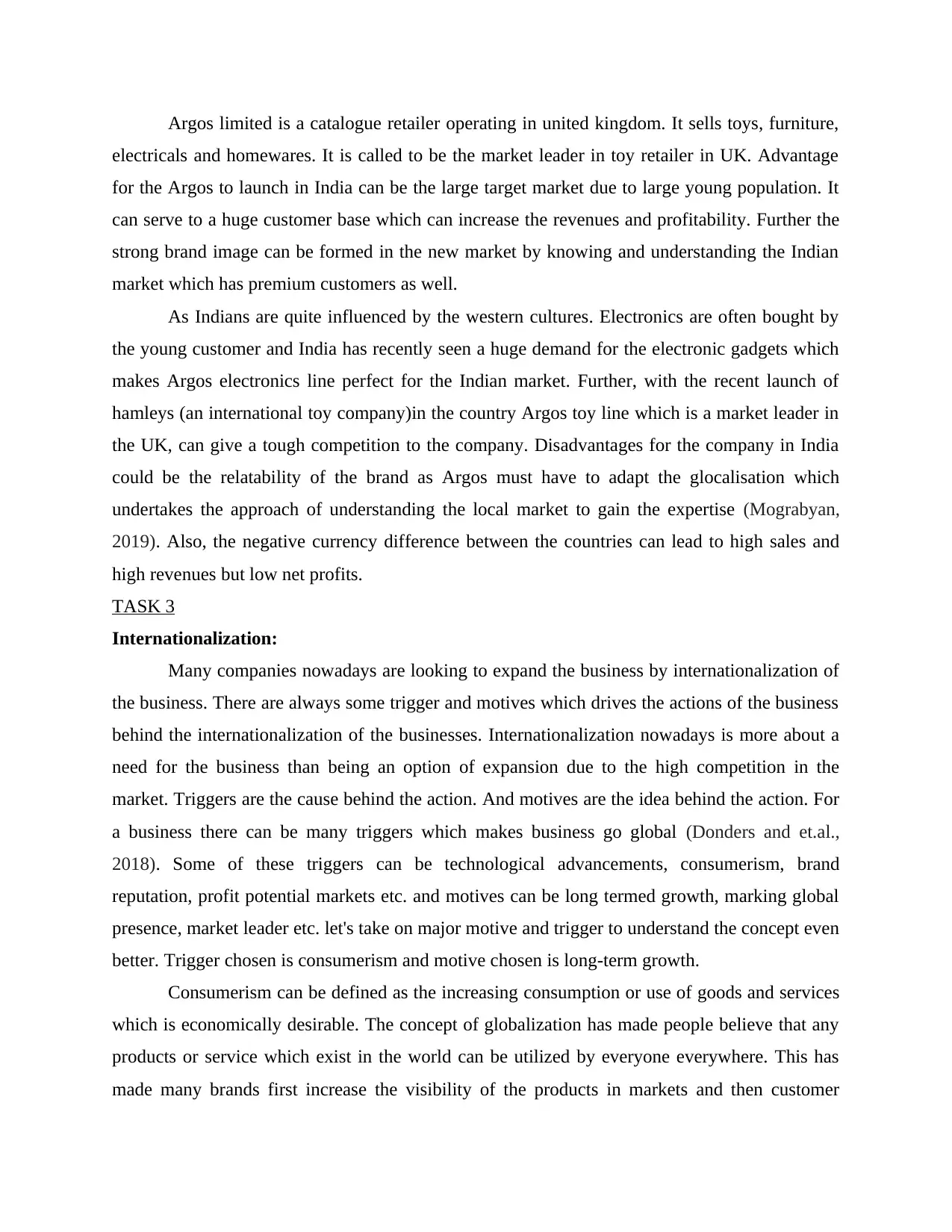
Argos limited is a catalogue retailer operating in united kingdom. It sells toys, furniture,
electricals and homewares. It is called to be the market leader in toy retailer in UK. Advantage
for the Argos to launch in India can be the large target market due to large young population. It
can serve to a huge customer base which can increase the revenues and profitability. Further the
strong brand image can be formed in the new market by knowing and understanding the Indian
market which has premium customers as well.
As Indians are quite influenced by the western cultures. Electronics are often bought by
the young customer and India has recently seen a huge demand for the electronic gadgets which
makes Argos electronics line perfect for the Indian market. Further, with the recent launch of
hamleys (an international toy company)in the country Argos toy line which is a market leader in
the UK, can give a tough competition to the company. Disadvantages for the company in India
could be the relatability of the brand as Argos must have to adapt the glocalisation which
undertakes the approach of understanding the local market to gain the expertise (Mograbyan,
2019). Also, the negative currency difference between the countries can lead to high sales and
high revenues but low net profits.
TASK 3
Internationalization:
Many companies nowadays are looking to expand the business by internationalization of
the business. There are always some trigger and motives which drives the actions of the business
behind the internationalization of the businesses. Internationalization nowadays is more about a
need for the business than being an option of expansion due to the high competition in the
market. Triggers are the cause behind the action. And motives are the idea behind the action. For
a business there can be many triggers which makes business go global (Donders and et.al.,
2018). Some of these triggers can be technological advancements, consumerism, brand
reputation, profit potential markets etc. and motives can be long termed growth, marking global
presence, market leader etc. let's take on major motive and trigger to understand the concept even
better. Trigger chosen is consumerism and motive chosen is long-term growth.
Consumerism can be defined as the increasing consumption or use of goods and services
which is economically desirable. The concept of globalization has made people believe that any
products or service which exist in the world can be utilized by everyone everywhere. This has
made many brands first increase the visibility of the products in markets and then customer
electricals and homewares. It is called to be the market leader in toy retailer in UK. Advantage
for the Argos to launch in India can be the large target market due to large young population. It
can serve to a huge customer base which can increase the revenues and profitability. Further the
strong brand image can be formed in the new market by knowing and understanding the Indian
market which has premium customers as well.
As Indians are quite influenced by the western cultures. Electronics are often bought by
the young customer and India has recently seen a huge demand for the electronic gadgets which
makes Argos electronics line perfect for the Indian market. Further, with the recent launch of
hamleys (an international toy company)in the country Argos toy line which is a market leader in
the UK, can give a tough competition to the company. Disadvantages for the company in India
could be the relatability of the brand as Argos must have to adapt the glocalisation which
undertakes the approach of understanding the local market to gain the expertise (Mograbyan,
2019). Also, the negative currency difference between the countries can lead to high sales and
high revenues but low net profits.
TASK 3
Internationalization:
Many companies nowadays are looking to expand the business by internationalization of
the business. There are always some trigger and motives which drives the actions of the business
behind the internationalization of the businesses. Internationalization nowadays is more about a
need for the business than being an option of expansion due to the high competition in the
market. Triggers are the cause behind the action. And motives are the idea behind the action. For
a business there can be many triggers which makes business go global (Donders and et.al.,
2018). Some of these triggers can be technological advancements, consumerism, brand
reputation, profit potential markets etc. and motives can be long termed growth, marking global
presence, market leader etc. let's take on major motive and trigger to understand the concept even
better. Trigger chosen is consumerism and motive chosen is long-term growth.
Consumerism can be defined as the increasing consumption or use of goods and services
which is economically desirable. The concept of globalization has made people believe that any
products or service which exist in the world can be utilized by everyone everywhere. This has
made many brands first increase the visibility of the products in markets and then customer

develops the need to buy those products and companies then launch such products in the
international market which enhances the business revenues and profitability. This makes for the
best strategy for a company. e.g. the body shop is a British based cosmetic, skin care & perfume
company which went international (Hall and Werbner, 2020). This company first increased the
visibility of its product to international consumers via bloggers, vloggers and various social
media influencers whose content was consumed by people from different country, this increased
the visibility of the brand. And because of the consumerism the demand was created among
international market which lead to internationalization of the brand.
Motive of long term growth is present behind every business that expands in international
markets. When a business takes any action it always thinks of it as a mean to develop and grow,
as this is the ultimate purpose of the company in the both short and long term. Long term growth
in terms of revenue, profits, brand image, reputation, relatability and large customer base. In
current times the growth and expansions are used as synonyms which says a lot about the
internationalization. A companies choice of internationalization has these motives attached.
As having these motives induced the vision and mission of the company which enhances
the productivity of the company (Zajda and Majhanovich, 2021). e.g. Estee lauder companies, is
a cosmetic brand which went international with its strong motive for long term growth for the
company. It has understood various different markets before the product launch and has features
and positioned with the aim of long term growth in foreign markets. Company understands the
requirement of long term growth by meeting the various quality and relatability related measures.
Therefore, with the clear example of both the body shop and Estee lauder companies it can be
understood that motive and triggers plays an important role in internationalization of the
companies.
TASK 4
Waterfall approach versus the shower approach:
These methods are the international entry modes used by the companies to expand the
business globally. In today's world internationalization is more about the necessity than being an
option. There is high competition in every industry which requires the businesses to be the first
one to grab any unexplored market and the existing markets as well. This requires companies to
adapt the entry modes into the international markets.
international market which enhances the business revenues and profitability. This makes for the
best strategy for a company. e.g. the body shop is a British based cosmetic, skin care & perfume
company which went international (Hall and Werbner, 2020). This company first increased the
visibility of its product to international consumers via bloggers, vloggers and various social
media influencers whose content was consumed by people from different country, this increased
the visibility of the brand. And because of the consumerism the demand was created among
international market which lead to internationalization of the brand.
Motive of long term growth is present behind every business that expands in international
markets. When a business takes any action it always thinks of it as a mean to develop and grow,
as this is the ultimate purpose of the company in the both short and long term. Long term growth
in terms of revenue, profits, brand image, reputation, relatability and large customer base. In
current times the growth and expansions are used as synonyms which says a lot about the
internationalization. A companies choice of internationalization has these motives attached.
As having these motives induced the vision and mission of the company which enhances
the productivity of the company (Zajda and Majhanovich, 2021). e.g. Estee lauder companies, is
a cosmetic brand which went international with its strong motive for long term growth for the
company. It has understood various different markets before the product launch and has features
and positioned with the aim of long term growth in foreign markets. Company understands the
requirement of long term growth by meeting the various quality and relatability related measures.
Therefore, with the clear example of both the body shop and Estee lauder companies it can be
understood that motive and triggers plays an important role in internationalization of the
companies.
TASK 4
Waterfall approach versus the shower approach:
These methods are the international entry modes used by the companies to expand the
business globally. In today's world internationalization is more about the necessity than being an
option. There is high competition in every industry which requires the businesses to be the first
one to grab any unexplored market and the existing markets as well. This requires companies to
adapt the entry modes into the international markets.
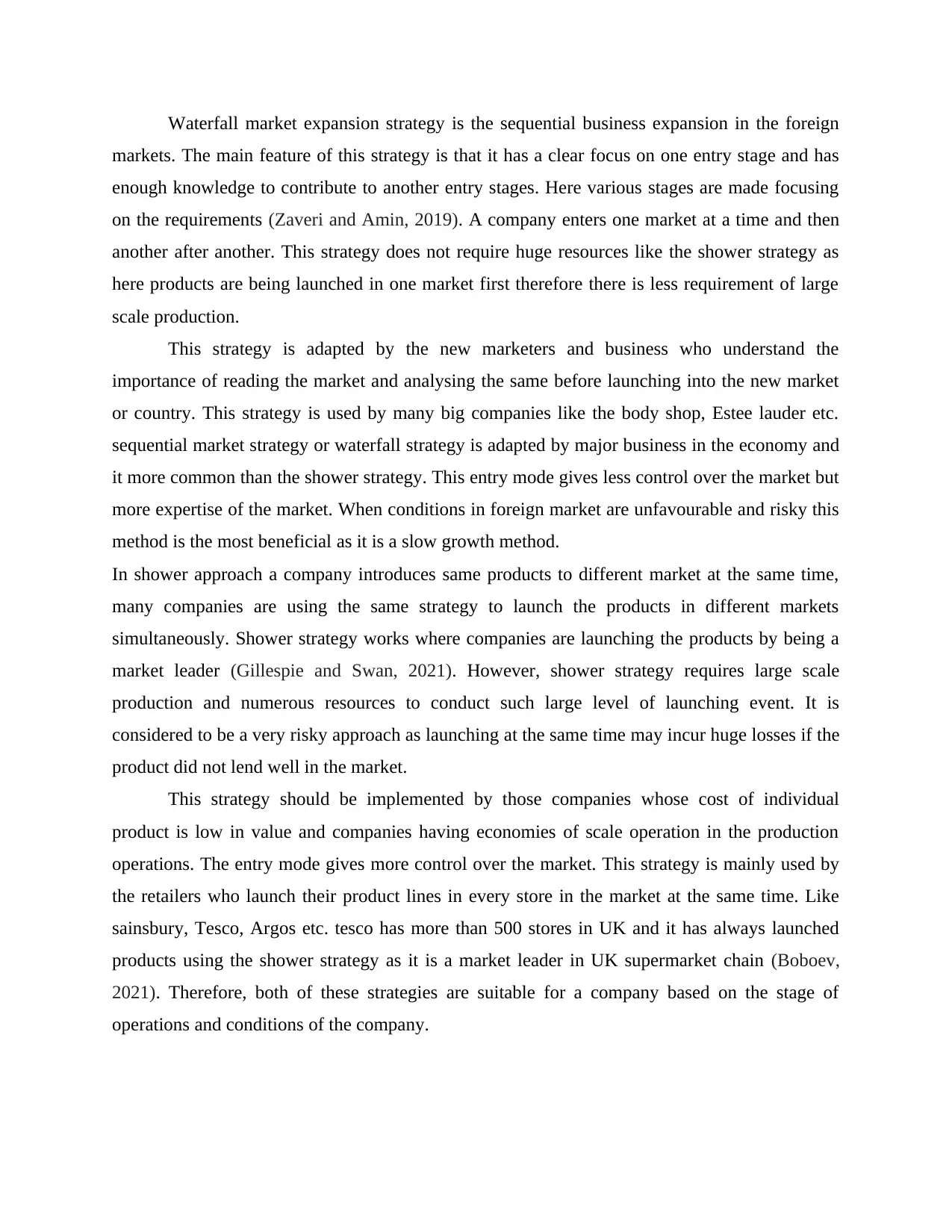
Waterfall market expansion strategy is the sequential business expansion in the foreign
markets. The main feature of this strategy is that it has a clear focus on one entry stage and has
enough knowledge to contribute to another entry stages. Here various stages are made focusing
on the requirements (Zaveri and Amin, 2019). A company enters one market at a time and then
another after another. This strategy does not require huge resources like the shower strategy as
here products are being launched in one market first therefore there is less requirement of large
scale production.
This strategy is adapted by the new marketers and business who understand the
importance of reading the market and analysing the same before launching into the new market
or country. This strategy is used by many big companies like the body shop, Estee lauder etc.
sequential market strategy or waterfall strategy is adapted by major business in the economy and
it more common than the shower strategy. This entry mode gives less control over the market but
more expertise of the market. When conditions in foreign market are unfavourable and risky this
method is the most beneficial as it is a slow growth method.
In shower approach a company introduces same products to different market at the same time,
many companies are using the same strategy to launch the products in different markets
simultaneously. Shower strategy works where companies are launching the products by being a
market leader (Gillespie and Swan, 2021). However, shower strategy requires large scale
production and numerous resources to conduct such large level of launching event. It is
considered to be a very risky approach as launching at the same time may incur huge losses if the
product did not lend well in the market.
This strategy should be implemented by those companies whose cost of individual
product is low in value and companies having economies of scale operation in the production
operations. The entry mode gives more control over the market. This strategy is mainly used by
the retailers who launch their product lines in every store in the market at the same time. Like
sainsbury, Tesco, Argos etc. tesco has more than 500 stores in UK and it has always launched
products using the shower strategy as it is a market leader in UK supermarket chain (Boboev,
2021). Therefore, both of these strategies are suitable for a company based on the stage of
operations and conditions of the company.
markets. The main feature of this strategy is that it has a clear focus on one entry stage and has
enough knowledge to contribute to another entry stages. Here various stages are made focusing
on the requirements (Zaveri and Amin, 2019). A company enters one market at a time and then
another after another. This strategy does not require huge resources like the shower strategy as
here products are being launched in one market first therefore there is less requirement of large
scale production.
This strategy is adapted by the new marketers and business who understand the
importance of reading the market and analysing the same before launching into the new market
or country. This strategy is used by many big companies like the body shop, Estee lauder etc.
sequential market strategy or waterfall strategy is adapted by major business in the economy and
it more common than the shower strategy. This entry mode gives less control over the market but
more expertise of the market. When conditions in foreign market are unfavourable and risky this
method is the most beneficial as it is a slow growth method.
In shower approach a company introduces same products to different market at the same time,
many companies are using the same strategy to launch the products in different markets
simultaneously. Shower strategy works where companies are launching the products by being a
market leader (Gillespie and Swan, 2021). However, shower strategy requires large scale
production and numerous resources to conduct such large level of launching event. It is
considered to be a very risky approach as launching at the same time may incur huge losses if the
product did not lend well in the market.
This strategy should be implemented by those companies whose cost of individual
product is low in value and companies having economies of scale operation in the production
operations. The entry mode gives more control over the market. This strategy is mainly used by
the retailers who launch their product lines in every store in the market at the same time. Like
sainsbury, Tesco, Argos etc. tesco has more than 500 stores in UK and it has always launched
products using the shower strategy as it is a market leader in UK supermarket chain (Boboev,
2021). Therefore, both of these strategies are suitable for a company based on the stage of
operations and conditions of the company.
Paraphrase This Document
Need a fresh take? Get an instant paraphrase of this document with our AI Paraphraser
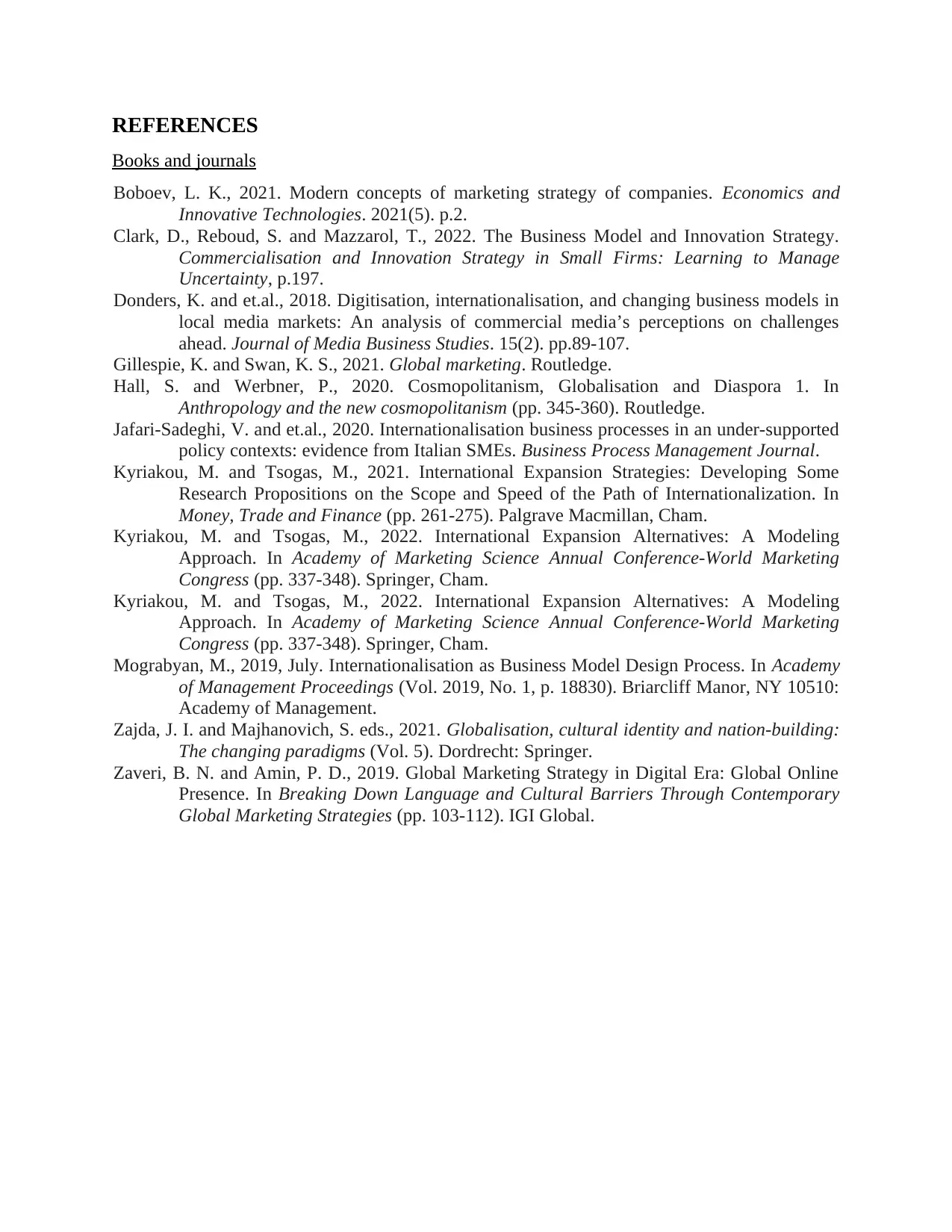
REFERENCES
Books and journals
Boboev, L. K., 2021. Modern concepts of marketing strategy of companies. Economics and
Innovative Technologies. 2021(5). p.2.
Clark, D., Reboud, S. and Mazzarol, T., 2022. The Business Model and Innovation Strategy.
Commercialisation and Innovation Strategy in Small Firms: Learning to Manage
Uncertainty, p.197.
Donders, K. and et.al., 2018. Digitisation, internationalisation, and changing business models in
local media markets: An analysis of commercial media’s perceptions on challenges
ahead. Journal of Media Business Studies. 15(2). pp.89-107.
Gillespie, K. and Swan, K. S., 2021. Global marketing. Routledge.
Hall, S. and Werbner, P., 2020. Cosmopolitanism, Globalisation and Diaspora 1. In
Anthropology and the new cosmopolitanism (pp. 345-360). Routledge.
Jafari-Sadeghi, V. and et.al., 2020. Internationalisation business processes in an under-supported
policy contexts: evidence from Italian SMEs. Business Process Management Journal.
Kyriakou, M. and Tsogas, M., 2021. International Expansion Strategies: Developing Some
Research Propositions on the Scope and Speed of the Path of Internationalization. In
Money, Trade and Finance (pp. 261-275). Palgrave Macmillan, Cham.
Kyriakou, M. and Tsogas, M., 2022. International Expansion Alternatives: A Modeling
Approach. In Academy of Marketing Science Annual Conference-World Marketing
Congress (pp. 337-348). Springer, Cham.
Kyriakou, M. and Tsogas, M., 2022. International Expansion Alternatives: A Modeling
Approach. In Academy of Marketing Science Annual Conference-World Marketing
Congress (pp. 337-348). Springer, Cham.
Mograbyan, M., 2019, July. Internationalisation as Business Model Design Process. In Academy
of Management Proceedings (Vol. 2019, No. 1, p. 18830). Briarcliff Manor, NY 10510:
Academy of Management.
Zajda, J. I. and Majhanovich, S. eds., 2021. Globalisation, cultural identity and nation-building:
The changing paradigms (Vol. 5). Dordrecht: Springer.
Zaveri, B. N. and Amin, P. D., 2019. Global Marketing Strategy in Digital Era: Global Online
Presence. In Breaking Down Language and Cultural Barriers Through Contemporary
Global Marketing Strategies (pp. 103-112). IGI Global.
Books and journals
Boboev, L. K., 2021. Modern concepts of marketing strategy of companies. Economics and
Innovative Technologies. 2021(5). p.2.
Clark, D., Reboud, S. and Mazzarol, T., 2022. The Business Model and Innovation Strategy.
Commercialisation and Innovation Strategy in Small Firms: Learning to Manage
Uncertainty, p.197.
Donders, K. and et.al., 2018. Digitisation, internationalisation, and changing business models in
local media markets: An analysis of commercial media’s perceptions on challenges
ahead. Journal of Media Business Studies. 15(2). pp.89-107.
Gillespie, K. and Swan, K. S., 2021. Global marketing. Routledge.
Hall, S. and Werbner, P., 2020. Cosmopolitanism, Globalisation and Diaspora 1. In
Anthropology and the new cosmopolitanism (pp. 345-360). Routledge.
Jafari-Sadeghi, V. and et.al., 2020. Internationalisation business processes in an under-supported
policy contexts: evidence from Italian SMEs. Business Process Management Journal.
Kyriakou, M. and Tsogas, M., 2021. International Expansion Strategies: Developing Some
Research Propositions on the Scope and Speed of the Path of Internationalization. In
Money, Trade and Finance (pp. 261-275). Palgrave Macmillan, Cham.
Kyriakou, M. and Tsogas, M., 2022. International Expansion Alternatives: A Modeling
Approach. In Academy of Marketing Science Annual Conference-World Marketing
Congress (pp. 337-348). Springer, Cham.
Kyriakou, M. and Tsogas, M., 2022. International Expansion Alternatives: A Modeling
Approach. In Academy of Marketing Science Annual Conference-World Marketing
Congress (pp. 337-348). Springer, Cham.
Mograbyan, M., 2019, July. Internationalisation as Business Model Design Process. In Academy
of Management Proceedings (Vol. 2019, No. 1, p. 18830). Briarcliff Manor, NY 10510:
Academy of Management.
Zajda, J. I. and Majhanovich, S. eds., 2021. Globalisation, cultural identity and nation-building:
The changing paradigms (Vol. 5). Dordrecht: Springer.
Zaveri, B. N. and Amin, P. D., 2019. Global Marketing Strategy in Digital Era: Global Online
Presence. In Breaking Down Language and Cultural Barriers Through Contemporary
Global Marketing Strategies (pp. 103-112). IGI Global.

1 out of 9
Related Documents
Your All-in-One AI-Powered Toolkit for Academic Success.
+13062052269
info@desklib.com
Available 24*7 on WhatsApp / Email
![[object Object]](/_next/static/media/star-bottom.7253800d.svg)
Unlock your academic potential
© 2024 | Zucol Services PVT LTD | All rights reserved.





